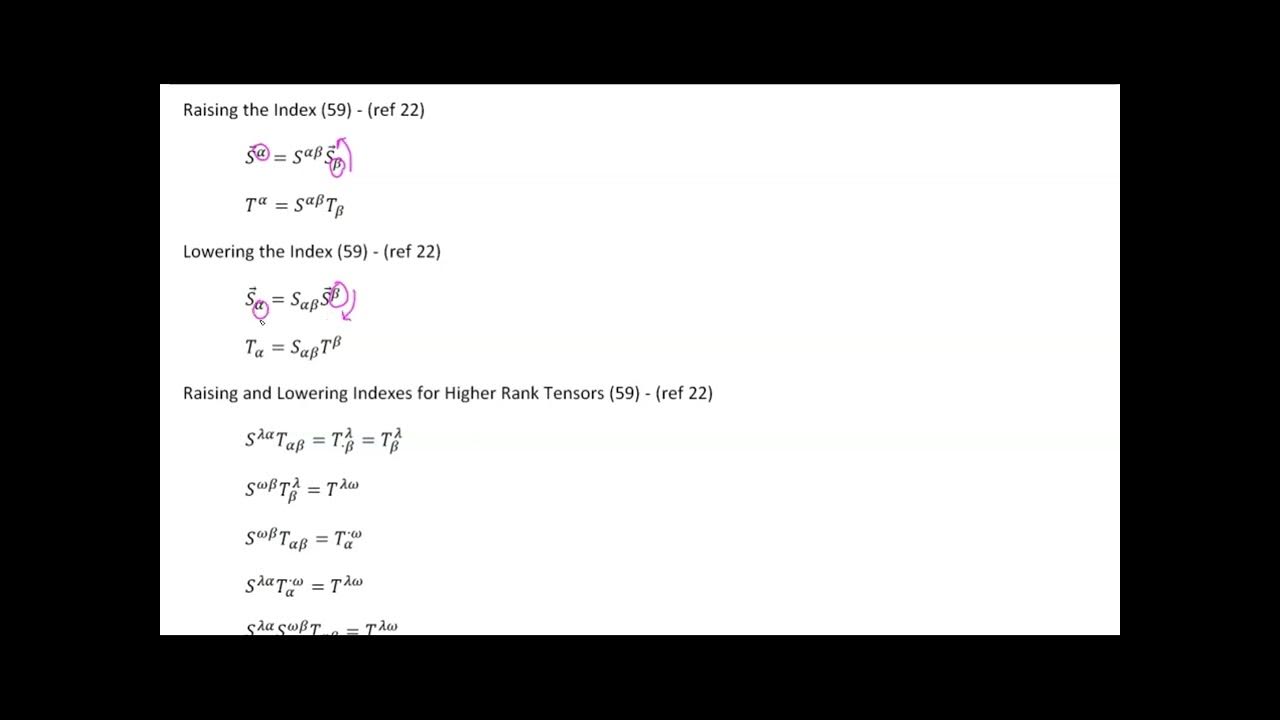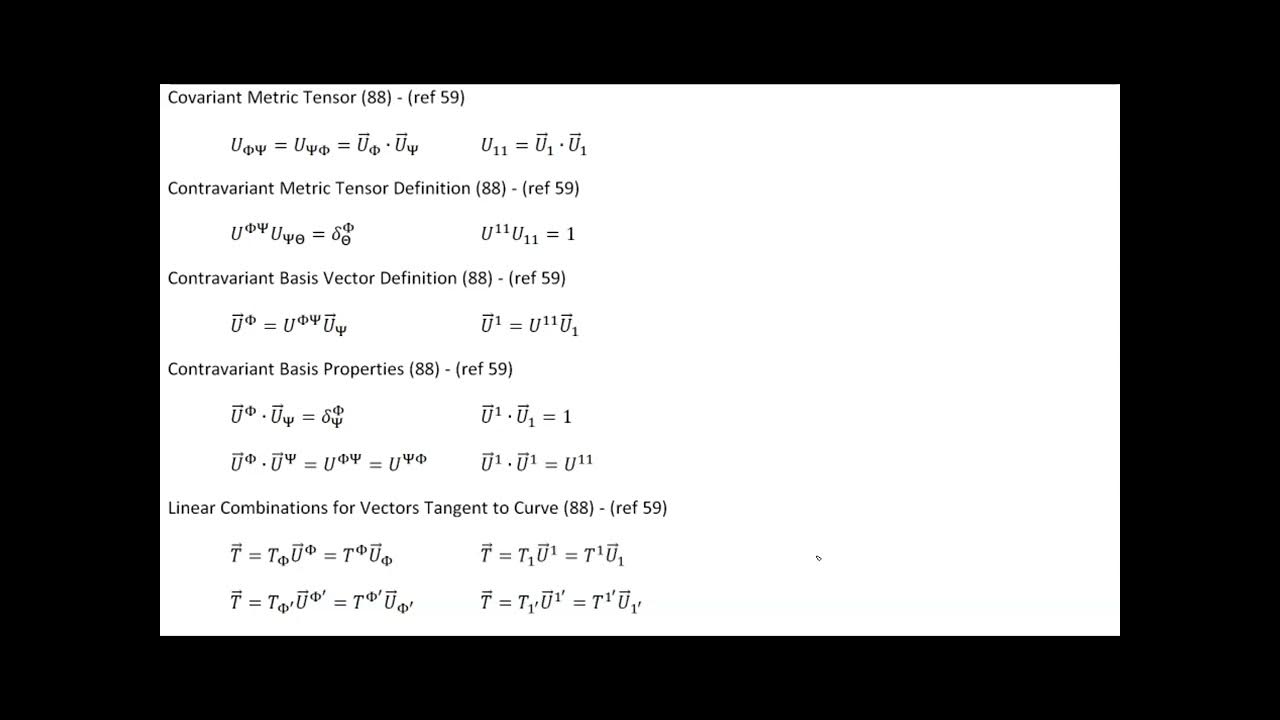Video 02 - Euclidean Space
TLDRThis video delves into the basics of tensor calculus within the context of Euclidean space, highlighting its three-dimensional nature and properties such as homogeneity and isotropy. It introduces the concepts of scalars, vectors, and tensors, explaining their roles and differences, and emphasizes the importance of understanding Euclidean space as the foundation for more complex manifolds. The video also touches on the historical use of tensors in analyzing structural forces in materials, showcasing their relevance in various scientific fields.
Takeaways
- 📚 Tensor calculus is initially limited to Euclidean space but is applicable to any manifold, with Euclidean space serving as the most basic example.
- 🌐 Euclidean space is characterized by three dimensions, three degrees of freedom, and the ability to draw straight lines and measure distances between points.
- 📐 The concept of angles between line segments and the use of the law of cosines to define the metric of space are fundamental in Euclidean geometry.
- 🔍 Euclidean space is homogeneous, isotropic, and flat, with a unique way to construct parallel lines according to Euclid's fifth postulate.
- 🛠️ The properties of Euclidean space include linearity, continuity, and differentiability, with a specific metric formula based on the law of cosines.
- 🔢 Scalars are real numbers representing quantifiable entities without directional significance, such as temperature, mass, and pressure.
- 📏 Vectors are geometric objects with both magnitude and direction, used to represent quantities like velocity, acceleration, and force.
- 🧭 Vector decomposition into coordinate components is unique to each coordinate system, but the vector itself remains an invariant geometric object.
- 📦 Tensors encompass scalars and vectors and can have ranks from 0 to any non-negative integer, with the number of components depending on the rank and the dimension of the space.
- 🔧 Tensors were historically used to analyze structural forces in materials and have found applications in various scientific fields, including fluid mechanics and general relativity.
- 🌌 The script concludes with a preview of the next topic, which will be tensor fields, expanding the discussion beyond the foundational concepts covered in the video.
Q & A
What is the primary focus of the video script?
-The video script focuses on introducing the basics of tensor calculus in Euclidean space, explaining the properties of Euclidean space, and the concepts of scalars, vectors, and tensors.
Why does the script initially limit the discussion to Euclidean space?
-The script limits the discussion to Euclidean space because it is the most basic and elementary example of a manifold, and understanding tensor calculus in this context provides a logical starting point before moving on to more complex manifolds.
What is the significance of the assumption that the viewer already understands Euclidean space?
-The assumption that the viewer understands Euclidean space allows the script to take a common sense approach, building upon familiar concepts without needing to define every term from scratch.
How does the script use graphing software to review characteristics of Euclidean space?
-The script uses graphing software to visually demonstrate points, lines, angles, and planes in Euclidean space, reinforcing the three-dimensional nature and the concept of distance between points.
What is the metric of a space, and how is it related to Euclidean space?
-The metric of a space defines how the distance between two points is determined. In Euclidean space, the metric is given by a formula equivalent to the law of cosines, which is used to calculate the length of a line segment between two points.
Why is the concept of a parallel line unique in Euclidean space?
-In Euclidean space, the concept of a parallel line is unique due to Euclid's fifth postulate, which states that through a point not on a line, there is exactly one line parallel to the given line.
What are the properties of Euclidean space as summarized in the script?
-Euclidean space is homogeneous (no preferred origin), isotropic (no preferred direction), flat, linear, and continuous (differentiable). It also has a well-defined metric for distance between points.
What is the difference between scalars and vectors according to the script?
-Scalars are real numbers representing quantifiable entities without directional significance, such as temperature or mass. Vectors, on the other hand, are geometric objects that include both magnitude and direction, like velocity or force.
How does the script explain the decomposition of vectors into coordinate components?
-The script explains that vectors can be decomposed into coordinate components for analytical purposes, but it emphasizes that this decomposition is unique to each coordinate system and that the vector itself remains an invariant geometric object.
What is the role of tensors in the context of the script?
-Tensors are a broader class of geometric objects that include scalars (rank 0 tensors) and vectors (rank 1 tensors). They can have any rank and are used to represent more complex relationships in space, such as shear stress and compression in materials.
Why were tensors historically first employed in analyzing structural forces?
-Tensors were first employed in analyzing structural forces because they provide a way to represent the nine different components needed to understand shear stress and compression in material substances.
Outlines
📚 Introduction to Tensor Calculus in Euclidean Space
This paragraph introduces the concept of tensor calculus, emphasizing its initial focus on Euclidean space before expanding to more complex manifolds. It explains that Euclidean space, being the most basic type of manifold, serves as a logical starting point for understanding tensor calculus. The paragraph also touches on the common-sense approach to understanding Euclidean space, assuming prior familiarity with its three-dimensional nature and properties such as points, lines, distances, angles, and planes. The importance of the metric in defining distances is highlighted, along with the uniqueness of parallel lines in Euclidean geometry.
📐 Properties of Euclidean Space and Transition to Scalars, Vectors, and Tensors
The second paragraph delves into the properties of Euclidean space, noting its homogeneity, isotropy, and flatness. It mentions the absence of a preferred origin or direction, and the continuous, differentiable nature of the space. The metric formula for Euclidean space is introduced, which is akin to the law of cosines. The paragraph transitions to discussing the nature of scalars, vectors, and tensors, explaining that scalars are real numbers without directional significance, while vectors include both magnitude and direction, making them suitable for representing quantities like velocity and force. The decomposition of vectors into coordinate components is also discussed, emphasizing the dependency of these components on the chosen coordinate system.
🔍 Deep Dive into Tensors: Definitions, Ranks, and Applications
The final paragraph provides a detailed exploration of tensors, defining them as a broader class of geometric objects that encompass scalars and vectors. Tensors are described according to their rank, with scalars being rank 0 and vectors rank 1, and the possibility of tensors of any rank up to a non-negative integer r. The decomposition of tensors into components in an n-dimensional manifold is explained, with the number of components being n to the power of the tensor's rank. The historical context of tensors in analyzing structural forces is given, and their utility in various scientific fields such as fluid mechanics, electrodynamics, and general relativity is highlighted. The paragraph concludes with a preview of the next topic, tensor fields.
Mindmap
Keywords
💡Euclidean Space
💡Manifold
💡Tensor Calculus
💡Degrees of Freedom
💡Metric
💡Law of Cosines
💡Scalar
💡Vector
💡Tensor
💡Rank
💡Tensor Field
Highlights
Introduction to tensor calculus with a focus on Euclidean space, which is the most basic example of a manifold.
Tensor calculus is applicable to any manifold, but the video begins with Euclidean space for simplicity.
Euclidean space is three-dimensional with three degrees of freedom, allowing movement in any direction.
Demonstration of drawing a straight line between any two points and defining distance through line segments.
Explanation of angles between line segments and the three-dimensional nature of Euclidean space.
Introduction of the law of cosines and its importance in defining the metric of space.
Illustration of constructing a line parallel to another through a point not on the original line, emphasizing Euclid's fifth postulate.
Discussion on the uniqueness of parallel lines in Euclidean space compared to other spaces.
Introduction of surfaces in Euclidean space, including planes and non-flat shapes like ellipsoids.
Concept of area and volume in three-dimensional Euclidean space.
Summary of Euclidean space properties: homogeneity, isotropy, flatness, linearity, and continuity.
Differentiation between Euclidean and non-Euclidean manifolds, with the latter being more general.
Definition of scalars as real numbers without directional significance, such as temperature and mass.
Vectors as geometric objects with magnitude and direction, used for quantities like velocity and force.
Decomposition of vectors into coordinate components, unique to each coordinate system.
Tensors as a broader class of geometric objects including scalars and vectors, with any rank from 0 to r.
Tensors' decomposition into components based on the rank and dimensionality of the manifold.
Historical reference to tensors' use in analyzing structural forces in materials.
Tensors' applications in various scientific fields such as fluid mechanics and general relativity.
Upcoming introduction of tensor fields in the next video.
Transcripts
5.0 / 5 (0 votes)
Thanks for rating:





